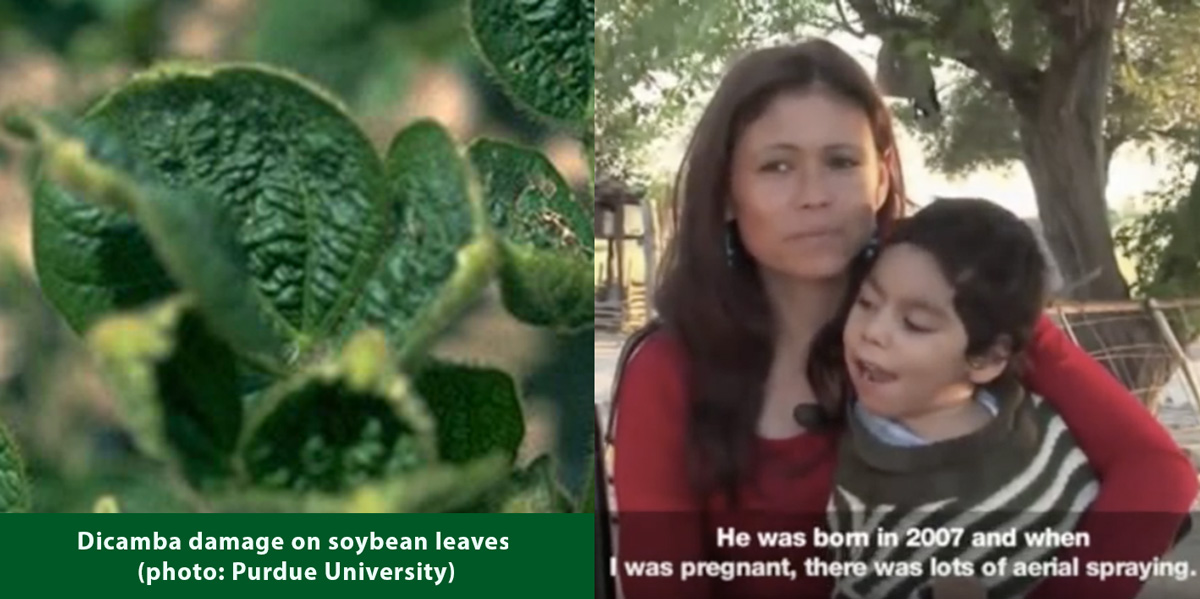
Time to call a halt to destructive GMO agricultural model that is linked with malformations in plants and people
We are sadly familiar with scientific reports linking human birth defects and miscarriages in South America with glyphosate herbicide spraying on GM glyphosate-tolerant soy. A boy born with severe birth defects in a GM soy-growing region of Argentina is pictured above right, from an Al-Jazeera report.
Now it seems that the GM agricultural model is also associated with malformations in plant offspring.
Many of us have seen images of deformed soybean plant leaves resulting from dicamba herbicide damage (an example is above left). Dicamba is sprayed on GM dicamba-tolerant soybeans but drifts off-target and damages non-dicamba-tolerant soybeans and other crops.
But a new paper (abstract below) reveals that dicamba doesn't only kill and damage the soybean plants that are in the line of fire of drift – it also makes its way into the seeds produced by those plants, resulting in deformed offspring.
Referring to different growth stages of the soybean plants (R1 to R6), the authors conclude, "This research documents that soybean damaged from dicamba drift during the R1 to R6 growth stages can negatively affect offspring and that occurrence of pod malformation after dicamba drift at the R5 growth stage may be indicative of injury to the offspring."
In addition, exposure of the parent plant to dicamba spraying during seed pod formation stages resulted in only 50% germination of seeds.
Broken system
Of course, such crop-specific research does not even consider the damage that is being done to an array of other cultivated and wild vegetation, including trees, that dicamba drift is impacting, and the knock-on effects of that damage, not only for seeds and plant offspring, but also for pollinators and the ecosystems they form part of.
The destruction wreaked on nature (including humans) by GMO agriculture shows that the system of scientific risk assessment that is claimed to be followed worldwide is broken. A new system of evaluating technologies – and deciding which ones we want to implement – is urgently required.
The new system needs to take into account the emotional trauma that most of us feel on seeing the profound damage caused by agrochemicals to human and plant offspring. But we should not have to wait for harmful effects to become widespread before rejecting destructive technologies.
Care ethics
Recently the EU Parliament's Green Party discussed the ecofeminist concept of "care ethics" as a new framework in which technologies like GM could be assessed.
In such a framework, emotions such as revulsion in the face of evidence of harm, as well as compassion for the beings harmed, are viewed as a legitimate reaction to new technologies and are taken into consideration in decision-making. In addition, the interconnected nature of the world is viewed as central, so that healthy relationships between humans, nature, crop plants, and technologies are prioritized.
Care ethics enables us to take a step back, consider the bigger picture, and reflect on what kind of world we want. Agrochemical-induced damage to human and plant offspring should have no place in our food production systems.
---
Response of soybean offspring to a dicamba drift event the previous year
Jones, G. T., Norsworthy, J. K., & Barber, T. (2019). Weed Technology, 33(1), 41-50.
https://www.cambridge.org/core/journals/weed-technology/article/response-of-soybean-offspring-to-a-dicamba-drift-event-the-previous-year/E5C507315E390EA84A52CF39F19CB256
Abstract
In the occurrence of dicamba drift, it is not well understood what measurements from soybean plants would correlate with damage to soybean offspring; therefore, possible relationships are of great interest. Sixteen drift trials were established in 2014 and 2015 at the Northeast Research and Extension Center in Keiser, AR. A single 8-m-wide by 30- or 60-m-long pass with a high-clearance sprayer was made in each soybean field, resulting in a dicamba drift event. Seeds were collected from plants in each drift trial and planted in the field in 2015 and 2016. Data were subjected to correlation analysis to determine pairwise associations among parent and offspring observations. Auxin-like symptomology in offspring consistent with dicamba, primarily as leaf cupping, appeared in plots at the unifoliate and first trifoliate stages. Auxin-like symptoms were more prevalent in offspring collected from plants from later reproductive stages as opposed to early reproductive stages. The highest correlation coefficients occurred when parent plants were treated at the R5 growth stage. Parent mature pod malformation was correlated with offspring emergence (r=−0.37, P=0.0082), vigor (r=−0.57, P ≤ 0.0001), injury (r=0.93, P ≤ 0.0001), and percent of plants injured (r=0.92, P ≤ 0.0001). This research documents that soybean damaged from dicamba drift during the R1 to R6 growth stages can negatively affect offspring and that occurrence of pod malformation after dicamba drift at the R5 growth stage may be indicative of injury to the offspring.